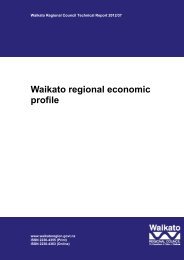Spatial distribution and seasonal variation in Undaria pinnatifida ...
Spatial distribution and seasonal variation in Undaria pinnatifida ...
Spatial distribution and seasonal variation in Undaria pinnatifida ...
You also want an ePaper? Increase the reach of your titles
YUMPU automatically turns print PDFs into web optimized ePapers that Google loves.
2. Introduction<strong>Undaria</strong> p<strong>in</strong>natifida (Harvey) Sur<strong>in</strong>gar is a large lam<strong>in</strong>arian kelp. <strong>Undaria</strong> is an annual with several different life stages. Itwas <strong>in</strong>troduced to New Zeal<strong>and</strong> waters <strong>in</strong> the 1980’s by Asian fish<strong>in</strong>g vessels (Parsons, 1994; Verlaque, 2007). <strong>Undaria</strong> isknown to have direct negative impacts on <strong>in</strong>digenous biota <strong>and</strong> it can change the entire structure of mar<strong>in</strong>e ecosystems(M<strong>in</strong>istry of Fisheries [MoF], 2001; Neill, 2008; Stuart, 2004). A s<strong>in</strong>gle <strong>Undaria</strong> plant can produce one hundred millionzoospores (Akiyama <strong>and</strong> Kurogi, 1982), mean<strong>in</strong>g the establishment of a s<strong>in</strong>gle mature plant is enough to found a vigorousnew population (Hay <strong>and</strong> Luckens, 1987). <strong>Undaria</strong> grows rapidly <strong>in</strong> favourable conditions <strong>and</strong> can form densemono‐specific st<strong>and</strong>s, allow<strong>in</strong>g it to out‐compete native species (Russell et al, 2008; Verlaque, 2007). <strong>Undaria</strong> has thepotential to displace macroalgae (e.g. Carpophyllum mascalocarpum, <strong>and</strong> Cystophora species) <strong>and</strong> other native speciessuch as paua (Hay <strong>and</strong> Luckens, 1987; Hay, 1990; MoF, 2001; Stuart, 2004), alter habitat for commercial species such asmussels, disrupt aquaculture activities, <strong>and</strong> may affect the cultural values of some mar<strong>in</strong>e sites (Cecere et al, 2000;Henkel <strong>and</strong> Hofmann, 2008; MoF, 2001; Neill, 2008; Russell et al, 2008; S<strong>in</strong>ner et al, 2000; Verlaque, 2007). Although<strong>Undaria</strong> can survive <strong>and</strong> reproduce at temperatures between zero <strong>and</strong> thirty degrees Celsius (Floc’h et al, 1991), growthof <strong>Undaria</strong> sporophytes (hereafter called plants) is optimum at 15-17 °C with growth cont<strong>in</strong>u<strong>in</strong>g slowly to 20°C (Saito,1975).S<strong>in</strong>ce its detection <strong>in</strong> Well<strong>in</strong>gton <strong>in</strong> 1987 (Hay & Luckens, 1987) <strong>Undaria</strong> has spread rapidly around New Zeal<strong>and</strong> coasts.Vessel hulls <strong>and</strong> aquaculture equipment are known to be the ma<strong>in</strong> dispersal pathways (Hay, 1990; Neill, 2008; Russell etal, 2008; S<strong>in</strong>ner et al, 2000; Verlaque, 2007). <strong>Undaria</strong> is now widespread around most of New Zeal<strong>and</strong>’s eastern <strong>and</strong>southern coastl<strong>in</strong>es from Auckl<strong>and</strong> to Bluff (Neill, 2008; Russell et al, 2008; Verlaque, 2007).<strong>Undaria</strong> was first officially recorded, on mussel farm <strong>in</strong>frastructure, <strong>in</strong> the Firth of Thames <strong>in</strong> 2002 (Stuart, 2004). Musselfarmers report the presence of <strong>Undaria</strong> <strong>in</strong> the Firth of Thames s<strong>in</strong>ce 1999 (Jessop, 2006). It was officially recorded <strong>in</strong> theWaitemata Harbour at Hobson West mar<strong>in</strong>a, <strong>in</strong> 2004. A subsequent <strong>in</strong>vestigation <strong>in</strong>to the <strong>distribution</strong> <strong>and</strong> density of thispopulation by Stuart <strong>and</strong> McClary (2004) concluded <strong>Undaria</strong> had at that time been present <strong>in</strong> the Waitemata Harbour,<strong>in</strong>clud<strong>in</strong>g Westhaven Mar<strong>in</strong>a, for 3-4 years. Quantitative data on the extent <strong>and</strong> nature of <strong>Undaria</strong> populations <strong>in</strong> the widerHauraki Gulf <strong>in</strong>clud<strong>in</strong>g the Corom<strong>and</strong>el area are currently lack<strong>in</strong>g. The potential exists for this highly <strong>in</strong>vasive species tospread to regions regarded as hav<strong>in</strong>g high conservation values such as mar<strong>in</strong>e reserves <strong>and</strong> Hauraki Gulf Isl<strong>and</strong>s (MoF,2001; Neill, 2008). The impacts of <strong>Undaria</strong> are not well understood, but are expected to vary considerably depend<strong>in</strong>g onthe location (MAF, 2010; Parsons, 1994). Data on the <strong>distribution</strong> <strong>and</strong> biology of <strong>Undaria</strong> <strong>in</strong> the Hauraki Gulf is necessaryto determ<strong>in</strong>e the risks of future spread, the potential impact on environmental values <strong>and</strong> on mar<strong>in</strong>e farm<strong>in</strong>g, <strong>and</strong> <strong>in</strong>general to <strong>in</strong>form management decisions regard<strong>in</strong>g this <strong>in</strong>vasive species.The present study has two ma<strong>in</strong> objectives:1. Investigate the spatial <strong>distribution</strong> of <strong>Undaria</strong> populations <strong>and</strong> levels of <strong>in</strong>festation on mussel farms <strong>and</strong> adjacentcoastal sites around the Corom<strong>and</strong>el Pen<strong>in</strong>sula.2. Investigate <strong>seasonal</strong> <strong>variation</strong> <strong>in</strong> the structure <strong>and</strong> biology of <strong>Undaria</strong> populations at sites around the Corom<strong>and</strong>elPen<strong>in</strong>sula <strong>and</strong> at Westhaven Mar<strong>in</strong>a <strong>in</strong> the Waitemata Harbour. Sites at Corom<strong>and</strong>el <strong>and</strong> Westhaven weremonitored from June 2011 to July 2012.The first objective was <strong>in</strong>vestigated by carry<strong>in</strong>g out field surveys on mussel farms <strong>and</strong> areas of coast adjacent to musselfarms between November 2011 <strong>and</strong> February 2012 (Figure 1). The second objective was exam<strong>in</strong>ed with monthlymonitor<strong>in</strong>g of <strong>Undaria</strong> populations on two mussel farms <strong>in</strong> the Corom<strong>and</strong>el Harbour <strong>and</strong> fortnightly monitor<strong>in</strong>g atWesthaven Mar<strong>in</strong>a. Areas around the Corom<strong>and</strong>el with high boat traffic such as sw<strong>in</strong>g moor<strong>in</strong>g sites <strong>and</strong> boat ramps werealso surveyed <strong>in</strong> order to gather <strong>in</strong>formation around the potential mechanisms of spread of <strong>Undaria</strong>.3
















